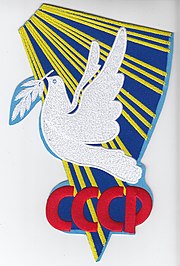Vostok 6
 The Vostok 6 capsule in a museum display (2016) | |
| Operator | Soviet space program |
|---|---|
| COSPAR ID | 1963-023A |
| SATCAT no. | 595 |
| Mission duration | 2 days, 22 hours, 50 minutes |
| Orbits completed | 48 |
| Spacecraft properties | |
| Spacecraft | OKB-1 |
| Launch mass | 4,713 kilograms (10,390 lb) |
| Crew | |
| Crew size | 1 |
| Members | Valentina Tereshkova |
| Callsign | Чайка (Chayka - "Seagull")[1] |
| Start of mission | |
| Launch date | 16 June 1963, 09:29:52 UTC |
| Rocket | 1/5[2] |
| End of mission | |
| Landing date | 19 June 1963, 08:20 UTC |
| Landing site | 53°12′34″N 80°48′14″E / 53.209375°N 80.80395°E[3] |
| Orbital parameters | |
| Reference system | Geocentric |
| Regime | Low Earth |
| Eccentricity | 0.00365 |
| Perigee altitude | 164 kilometres (102 mi) |
| Apogee altitude | 212 kilometres (132 mi) |
| Inclination | 65.09 degrees |
| Period | 88.25 minutes |
| Epoch | 16 June 1963, 05:36:00 UTC[4] |

Vostok program Crewed flights | |
Vostok 6 (Russian: Восток-6, Orient 6 or East 6) was the first human spaceflight to carry a woman, cosmonaut Valentina Tereshkova, into space.[5]
Mission
The spacecraft was launched on 16 June 1963. While
The Vostok 6 landing site coordinates are 53°12′34″N 80°48′14″E / 53.209375°N 80.80395°E, 200 km (120 mi) west of
The capsule is now on display at the
During flight
The Soviet state television network broadcast live video of Tereshkova from a camera inside the capsule, and she conversed with Premier Nikita Khrushchev over the radio. Communications with ground controllers about her overall health were described in post-flight reports as "evasive", and later official accounts of the mission had somewhat condescending remarks about Tereshkova's overall in-flight performance.[7]
In Tereshkova's account of the mission in her postflight debriefing, she mentioned having assorted body pains and difficulty with her helmet headset (also reported by Bykovsky on Vostok 5). She vomited while attempting to eat, although she attributed this to the taste of the food rather than her physical condition.[8] Another problem was that while the Soviet space agency had provided her with food, water and tooth paste, they had forgotten to pack a toothbrush.[9]
An official history of the Soviet space program published in 1973 described Tereshkova's physical condition and in-flight performance as udovletvoritel'noe (удовлетворительное, 'fair' or 'adequate') rather than otlichno (отлично, 'good' or 'outstanding').[10]
During landing
Like all the previous Vostok flights, Tereshkova had to eject. She landed safely by parachute.
It was revealed in 2004 that an error in the control program made the spaceship ascend from orbit instead of descending. Tereshkova noticed the fault on the first day of the flight and reported it to spacecraft designer
Pilot
Prime: Valentina Tereshkova – only spaceflight
Backup pilot: Irina Solovyova
Reserve pilot: Valentina Ponomaryova
Mission parameters]
- Mass: 4,713 kg (10,390 lb)
- Apogee: 231 km (144 mi)
- Perigee: 180 km (110 mi)
- Inclination: 64.9°
- Period: 87.8 minutes
References
- ISBN 0-7917-0188-3.
- ^ "Baikonur LC1". Encyclopedia Astronautica. Archived from the original on 2009-04-15. Retrieved 2009-03-30.
- ^ "Google Maps - Vostok 6 Landing Site - Monument Location". Retrieved 2010-12-25.
- ^ "NASA - NSSDCA - Spacecraft - Trajectory Details". nssdc.gsfc.nasa.gov. Retrieved 2018-05-02.
- ^ "1963: Soviets launch first woman into space". BBC. 1963-06-16. Retrieved 2015-11-28.
- ^ "Google Maps – Vostok 6 Landing Site − Monument Photo closeup". Retrieved 2023-01-10.
- ^ "Tereshkova orbits the Earth aboard Vostok-6". Russian in Space. 2013. Archived from the original on 30 June 2019. Retrieved 2019-10-06.
- ^ "Vostok 6". www.astronautix.com. Archived from the original on 2013-11-08. Retrieved 2015-11-28.
- ^ Knapton, Sarah (17 September 2015). "Russia forgot to send toothbrush with first woman in space". The Daily Telegraph. Archived from the original on 2016-03-24. Retrieved 20 January 2019.
- ^ "Tereshkova orbits the Earth aboard Vostok-6". Russian in Space. 2013. Archived from the original on 30 June 2019. Retrieved 2019-10-06.
- ^ a b "World First Woman Cosmonaut Speaks About Error of Vostok Designers". Kommersant. 2 March 2007. Archived from the original on 4 March 2007. Retrieved 2013-06-16.
- ISBN 0-7917-0188-3.
- ^ "Baikonur LC1". Encyclopedia Astronautica. Archived from the original on 2009-04-15. Retrieved 2009-03-30.
- ^ "Google Maps - Vostok 6 Landing Site - Monument Location". Retrieved 2010-12-25.
- ^ "NASA - NSSDCA - Spacecraft - Trajectory Details". nssdc.gsfc.nasa.gov. Retrieved 2018-05-02.
- ^ "1963: Soviets launch first woman into space". BBC. 1963-06-16. Retrieved 2015-11-28.
- ^ "Google Maps – Vostok 6 Landing Site − Monument Photo closeup". Retrieved 2023-01-10.
- ^ "Tereshkova orbits the Earth aboard Vostok-6". Russian in Space. 2013. Archived from the original on 30 June 2019. Retrieved 2019-10-06.
- ^ "Vostok 6". www.astronautix.com. Archived from the original on 2013-11-08. Retrieved 2015-11-28.
- ^ Knapton, Sarah (17 September 2015). "Russia forgot to send toothbrush with first woman in space". The Daily Telegraph. Archived from the original on 2016-03-24. Retrieved 20 January 2019.
- ^ "Tereshkova orbits the Earth aboard Vostok-6". Russian in Space. 2013. Archived from the original on 30 June 2019. Retrieved 2019-10-06.
- ^ a b "World First Woman Cosmonaut Speaks About Error of Vostok Designers". Kommersant. 2 March 2007. Archived from the original on 4 March 2007. Retrieved 2013-06-16.

